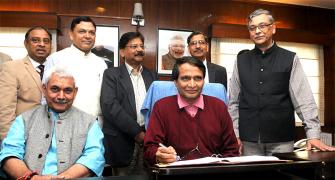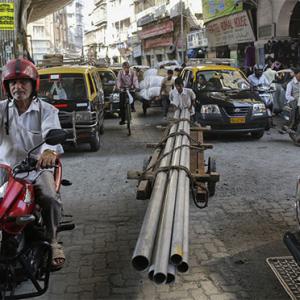
Current Status
Year 2015 saw home and electronic goods grow 8%, driven mainly by replacement buying in categories such as TVs and refrigerators. Companies attribute this to higher penetration levels of the two categories -- 60% for TVs and 21% for refrigerators.
The reason for real demand being on the lower side is linked to the discretionary slowdown which has gripped the market.
Urban consumers remain cautious, while rural ones have been hit on account of a poor monsoon, its impact on crop harvests, lower minimum support price and lower spending on rural.
Urban markets account for the major share of total revenues in the consumer durables sector in the country.
If the goods and services tax and recommendations of the seventh pay commission are implemented in 2016 by the government, things may turn bright for consumer durable industry.
India’s consumer durables industry is growing at a consistent rate, but most of the demand is met through imports.
India’s contribution to the GDP from its manufacturing sector is lower than the value added even by its neighbouring countries that have seen a decline in the last few years.
China stands as a shining example of a country that has risen from a manufacturing contribution of a mere 2.7% in 1990 to as much as 32% in the past year.
The government is determined and working on a collective approach to resolve key issues.
These include demand generation, profitability and sustainability, improving the efficiency of the global supply chain and creation of more employment opportunities.
The government launched its most ambitious initiative -- Make in India -- stressing on increasing domestic manufacturing in electronics, as this sector has been contributing to the India still remains a highly underpenetrated market, with sub-par levels as compared to the global average.
The need of the hour is to contemplate on the challenges which hamper the growth of the economy. The overall urban penetration has been pretty high for the consumer durables sector.
The rural and semi-urban areas are where the biggest potential for growth lies, and they will fuel industry growth through first-time sales.
Currently, rural areas contribute to 10% of overall sales and hence there is a strong need to undertake demand generation.
The government should provide incentives to manufacturers for exports to identified markets.
There is also a need to improve the procedural, regulatory and custom approvals, refunds, and clearances.
India has the potential to develop and manufacture electronics hardware for the global markets and meet its future requirements.
The way forward is to nurture a healthy relationship between the government and the industry to put India in a strong position on the global electronics map.
Industry Expectations
- Cut excise duty on consumer appliances; incentivise local production
Excise duty cut on consumer appliances is one of the key demands of the industry that is facing a fall in demand.
The government had introduced excise duty sops for consumer durables in 2014, which were later rolled back.
With the fall in rupee, the sector is eagerly awaiting a Budget that can stabilise the economy and give a boost to the struggling industry. A reduction in excise duty from 12 per cent to 10 will bring relief.
The Bureau of Energy Efficiency has been working towards stricter energy efficiency norms, which have also contributed to rising costs for the industry and rising prices for the consumers.
As the energy efficiency norms are getting tightened, industry players are finding it challenging to make some of the five-star rated products in categories, such as frost-free refrigerators, as the cost is exorbitant.
- Leave Higher disposable income with consumers
The industry is hoping the Budget will lead to more disposable income in the hands of the consumers to spur consumption.
- Correct the inverted duty structure
The industry is hoping that the government will remove inefficiencies in the system posed by the inverted duty structure.
Industry players are urging the government to remove basic customs duty levied on import of components used to make appliances such as refrigerators, air-conditioners and washing machines.
This will ensure a level playing field for the industry and encourage companies to manufacture appliances locally rather than import them into the country.
- Inter-state GST should be implemented prior to the full-fledged GST
- Section 80-I, investment allowance on capex should be without any lower threshold.
Any increase in social welfare and bonus expenses may be allowed as a 300% weighted deduction for the purpose of tax calculations.
In the interest of equity and fair play the onus for providing “C” Form for availing concessional tax on inter-state sales should shift to the purchaser from the supplier from retrospective effect.
Rates of Custom Duties on various stages of production -- from raw material to finished products may be finely differentiated allowing small breathing space to each of the value adder.
A study could be commissioned to identify potential sectors and slabs to encourage such backward integration
- The duty drawback rates should be aligned with the custom duty on its raw materials and on calculated quantity based on input-output norms already established. The drawback mechanism should also incorporate the temporary anti-dumping / safe-guard duties levied from time to time.
- Exemption of 4% SAD has been granted on all inputs/components used in the manufacturing of all ITA-1 items (except Populated PCB’s)
- CST on electronics value chain should be removed immediately as it is a major disincentive for domestic manufacturers. While the CST rate is 2%, the impact on the value chain is 5-6% due to its cascading effect
- LCD Panel FAB may be treated at par with Semi-Conductor Fab and should be offered similar benefits
- Zero duty on all inputs for manufacture of electronic components and parts, including dual use inputs for all ITA-1 items which results in inverted duty scenario.
- In addition to continuation of SAD, 5% Customs Duty should be imposed on fully assembled PCB Boards imported for manufacture of ITA-1 products and electronic equipment which is currently subject to Zero Customs Duty.
- To encourage domestic manufacturing of the entire value chain of ESDM industry, a duty differential of 6.5% (50% of Excise Duty) may be introduced.
- For all inputs of electronics industry, excise duty should be pegged at 6% (50% of the Tariff Rate) without CENVAT credit and 12.5% with CENVAT credit
- Similar to conventional lighting products, LED bulbs and Tubes should be assessed under sec 4(a) of the Central Excise Act, while other LED products that are largely used in commercial/industrial applications be exempted from MRP based valuations.
- Excise duty on stand-alone radio sets may be reduced to 8% (which is revenue neutral) and must be chargeable on ex-factory price. Presently, the Excise duty on this item is levied on MRP less abatement.
- To encourage manufacturers to make panels in India , the BLU modules, its parts and open cell should be allowed for import at a concessional custom duty of 0% without actual user condition.
- Customs Duty Exemption on inputs for Micro Fuses, Sub Miniature Fuses and Resettable Fuses
- Clarity with regards GST implementation
Analysts/market expectations
Some clarity may emerge on GST implementation during Budget session, however major sector related announcement may not happen. Any cuts on Excise Duty cut will be a positive surprise
Stock to watch
Videocon Industries, Havells, Bajaj Electricals, Panasonic Appliances India
Outlook
Tax reforms implementation should include a fast roll out of GST, so as to have an equitable tax system and unified market which, in turn, can improve efficiency and competitiveness.
Simplified and transparent tax policies will improve ease-of-doing business and reduce litigations or disputes, thereby building investor confidence and supporting the Make in India campaign.
India is expected to become the 5th largest consumer durables market in the world by 2025. The consumer electronics market is expected to increase to US$ 400 billion by 2020.
Demand in urban markets is expected to increase for non-essential products such as LED TVs, laptops, split ACs and, beauty and wellness products. In rural markets, durables like refrigerators as well as consumer electronic goods are likely to witness growing demand in the coming years as the government plans to invest significantly in rural electrification









